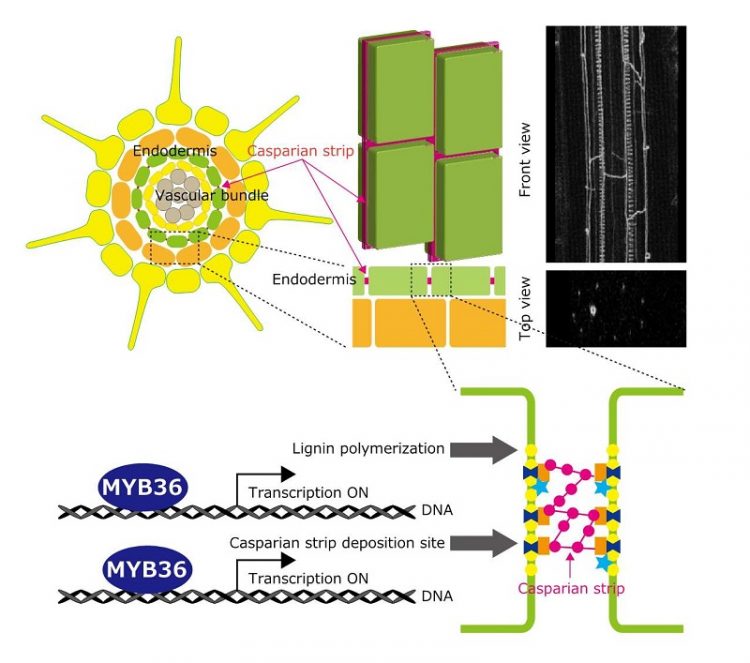Switch for building barrier in roots

*Casparian strip formation and MYB36 function. Copyright : © 2015 Takehiro Kamiya
Researchers at the University of Tokyo and Aberdeen University have identified the master switch for formation of the Casparian strip, a special structure in the root that plays an important role in nutrient uptake.
The Casparian strip is made of lignin, the main component of wood, deposited in a particular location (the anticlinal cell wall) in between endodermal cells in the root. By filling the gap between cells, the Casparian strip prevents harmful materials from entering into plants and also prevents leakage of nutrient from roots.
Although the Casparian strip was first described in 1865 by Robert Caspary and several proteins involved in its formation have been identified, the overall process remained unclear.
The research group of Lecturer Takehiro Kamiya at the University of Tokyo Graduate School of Agricultural and Life Sciences and Professor David E. Salt at the University of Aberdeen isolated an Arabidopsis thaliana mutant with altered leaf concentrations of elements and identified MYB36, a transcription factor, as the causal gene of the mutant.
MYB36 turns on transcription of multiple genes involved in Casparian strip formation, leading to localized lignin deposition in the Casparian strip formation site. Furthermore, the groups succeeded in building Casparian strip-like structures in cells which do not normally form Casparian strips by expressing MYB36 in those cells. These results demonstrate that MYB36 is the master regulator of Casparian strip formation.
This discovery will contribute to our understanding of the control of the Casparian strip and its function in plant nutrient absorption as well as to developing crops with improved efficiency of nutrient uptake.
*Image
Casparian strip is made of lignin deposited between endodermal cells. MYB36 positively regulates genes required for both polymerizing lignin and locating lignin polymerizing machinery to the Casparian strip deposition site.
Paper
Takehiro Kamiya, Monica Borghi, Peng Wang, John M. Danku, Lothar Kalmbach, Prashant S. Hosmani, Sadaf Naseer, Toru Fujiwara, Niko Geldner, David E. Salt, “The MYB36 transcription factor orchestrates Casparian strip formation”, Proceedings of the National Academy of Sciences of the United States of America Online Edition: 2015/6/30 (Japan time), doi: 10.1073/pnas.1507691112.
Associated links
UTokyo Research article
Media Contact
More Information:
http://www.researchsea.comAll latest news from the category: Life Sciences and Chemistry
Articles and reports from the Life Sciences and chemistry area deal with applied and basic research into modern biology, chemistry and human medicine.
Valuable information can be found on a range of life sciences fields including bacteriology, biochemistry, bionics, bioinformatics, biophysics, biotechnology, genetics, geobotany, human biology, marine biology, microbiology, molecular biology, cellular biology, zoology, bioinorganic chemistry, microchemistry and environmental chemistry.
Newest articles

NASA: Mystery of life’s handedness deepens
The mystery of why life uses molecules with specific orientations has deepened with a NASA-funded discovery that RNA — a key molecule thought to have potentially held the instructions for…

What are the effects of historic lithium mining on water quality?
Study reveals low levels of common contaminants but high levels of other elements in waters associated with an abandoned lithium mine. Lithium ore and mining waste from a historic lithium…

Quantum-inspired design boosts efficiency of heat-to-electricity conversion
Rice engineers take unconventional route to improving thermophotovoltaic systems. Researchers at Rice University have found a new way to improve a key element of thermophotovoltaic (TPV) systems, which convert heat…



